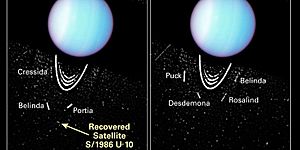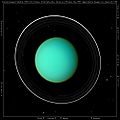Perdita (moon) facts for kids
| Discovery | |
|---|---|
| Discovered by | Erich Karkoschka / Voyager 2 |
| Discovery date | May 18, 1999 (in images dating back to January 18, 1986) |
| Orbital characteristics | |
|
Mean orbit radius
|
76,417 ± 1 km |
| Eccentricity | 0.0012 ± 0.0005 |
| 0.638021 ± 0.000013 d | |
| Inclination | 0.0 ± 0.3° (to Uranus' equator) |
| Satellite of | Uranus |
| Physical characteristics | |
| Dimensions | 30 × 30 × 30 km |
|
Mean radius
|
15 ± 3 km |
| ~2,800 km² | |
| Volume | ~14,000 km³ |
| Mass | ~0.18×1017 kg |
|
Mean density
|
~1.3 g/cm³ assumed |
| ~0.0047 m/s2 | |
| ~0.011 km/s | |
| synchronous | |
| zero | |
| Albedo | 0.08 ± 0.01 |
| Temperature | ~64 K |
Perdita is a small moon that orbits very close to the planet Uranus. Its discovery was quite a puzzle! The first images of Perdita were actually taken way back in 1986 by the Voyager 2 spacecraft. But for over ten years, nobody realized it was a moon in those pictures.
In 1999, a scientist named Erich Karkoschka finally spotted the moon in those old photos. He reported his discovery. However, because new pictures couldn't be taken right away to prove it was real, some thought it might not exist. But then, in 2003, the powerful Hubble Space Telescope took new pictures. These photos clearly showed an object right where Perdita was expected to be, finally confirming it was a real moon!
Contents
How Perdita Got Its Name
After its discovery in 1999, Perdita was first given a scientific name: S/1986 U 10. This name tells us it was the 10th moon discovered from images taken in 1986 around Uranus. Later, it was officially named after a character from William Shakespeare's play The Winter's Tale. Perdita is the daughter of Leontes and Hermione in the play. The moon is also known as Uranus XXV, meaning it's the 25th moon of Uranus to be officially recognized.
Perdita's Family of Moons
Perdita is part of a group of moons called the Portia Group. This family of moons also includes Bianca, Cressida, Desdemona, Portia, Juliet, Cupid, Rosalind, and Belinda. These moons all have similar orbits around Uranus and reflect light in similar ways.
What We Know About Perdita
Perdita is a very small moon, shaped a bit like a squashed ball. Its average size is about 15 km (about 9 miles) across. It reflects about 8% of the sunlight that hits it, which means it's quite dark. Beyond its size and orbit, scientists don't know much else about Perdita. It's a mysterious little world waiting to be explored further!
Images for kids
See also
 In Spanish: Perdita para niños
In Spanish: Perdita para niños



